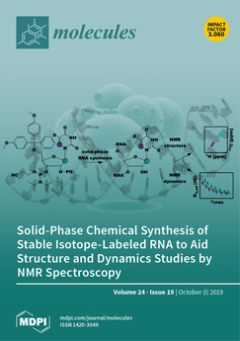The activation of halogen bonding by the substitution of the pentafluoro-λ
6-sulfanyl (SF
5) group was studied using a series of SF
5-substituted iodobenzenes. The simulated electrostatic potential values of SF
5-substituted iodobenzenes, the ab initio molecular orbital calculations
[...] Read more.
The activation of halogen bonding by the substitution of the pentafluoro-λ
6-sulfanyl (SF
5) group was studied using a series of SF
5-substituted iodobenzenes. The simulated electrostatic potential values of SF
5-substituted iodobenzenes, the ab initio molecular orbital calculations of intermolecular interactions of SF
5-substituted iodobenzenes with pyridine, and the
13C-NMR titration experiments of SF
5-substituted iodobenzenes in the presence of pyridine or tetra (
n-butyl) ammonium chloride (TBAC) indicated the obvious activation of halogen bonding, although this was highly dependent on the position of SF
5-substitution on the benzene ring. It was found that 3,5-bis-SF
5-iodobenzene was the most effective halogen bond donor, followed by
o-SF
5-substituted iodobenzene, while the
m- and
p-SF
5 substitutions did not activate the halogen bonding of iodobenzenes. The similar
ortho-effect was also confirmed by studies using a series of nitro (NO
2)-substituted iodobenzenes. These observations are in good agreement with the corresponding Mulliken charge of iodine. The 2:1 halogen bonding complex of 3,5-bis-SF
5-iodobenzene and 1,4-diazabicyclo[2.2.2]octane (DABCO) was also confirmed. Since SF
5-containing compounds have emerged as promising novel pharmaceutical and agrochemical candidates, the 3,5-bis-SF
5-iodobenzene unit may be an attractive fragment of rational drug design capable of halogen bonding with biomolecules.
Full article






